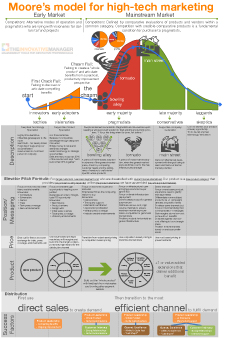It’s no secret that Amazon’s end game with hardware products is not to sell more hardware. For Bezo’s and company, it’s all about growing the number of Prime subscribers.
Why? Two big reasons (according to RBC Capital Markets Survey):
- Prime subscribers spend almost twice as much as non-subscribers.
- Kindle device owners spend almost 30% more on Amazon than non-Kindle owners.
This is why Amazon keeps developing hardware products such as Fire TV and Fire phone and why they continually sweeten the pot of Prime benefits – such as the recent announcement of adding a music service with a million songs.

FREE VIDEO TRAINING FOR INNOVATORS
Over 100 Slides Free and Downloadable as a PDF
Like all cost leaders, Amazon’s mission is to grow sales volume and let profitability land where it may. The following chart of Amazon’s revenue and net profit over time illustrate how successful (and focused) the company has been on executing this strategy.
For at least the last 10 years, Amazon has made enormous revenues but virtually zero profits. But despite lacking profits, Amazon’s stock price continues to go up with every increase in revenue…
Investors know that any business that grows revenue 25% per year will one day be able to reap enormous profits.
This low-cost, volume-based business strategy drives Amazon’s product strategy as well. By creating low-cost hardware offerings, Amazon is able to persuade more customers to join the Prime ecosystem. In return, Amazon gets the higher likelihood of long-time Prime members and their higher propensity to purchase more products and services through Amazon.
The best example of how this low-cost hardware strategy can succeed is the Kindle Fire tablet. When it was announced in September 2011, the iPad 2 was the king of tablets. But at $499 for the base model, a large number of people still were not willing to take the plunge.
That is until the Kindle Fire fully commoditized the tablet industry. At launch, Kindle Fire was priced at $199, a bargain for a tablet that had most of the iPad’s capabilities. This comparison from Reuters tells the story well…
Kindle Fire sales soared – and likely so did Prime memberships. Such is how a successful cost leadership strategy is executed. Cheap. Fast. Volume. Repeat.
Now enter the Fire Phone, a device with fancy new 3D technology and an exorbitant price tag ($199 on a 2-year contract only available through AT&T), being paraded as the next big thing in smartphone technology. The device also represents a radical departure from the low-cost leader strategy that served them so well in the past.
Even though I’m a techie and the phone looks like it would be neat to use on occasion, the business and marketing person in me is left shaking my head.
Let’s start with the technology.
The debut of Fire Phone brings with it the capability of the screen to simulate 3D interactions thanks to four infrared cameras mounted at each corner of the front of the phone which are tracking your head movements. Is this the next major revolution is smartphone technology, deserving of an Apple-like benefit leader strategy complete with an enormous price tag and an exclusive wireless carrier partnership?
Hardly.
Though the technology has promise for some interesting gaming and personal navigation capabilities, until a critical mass of developers get on board, the feature will be little more than a marketing gimmick. And with the phone’s potential reach locked to a small subset of AT&T users who are really gung ho about Amazon, I wouldn’t hold your breath for developers to jump on board. Why would they when they can reach millions of people world-wide through Google Play and the Apple App Store? Sorry folks, nothing to see here.
Now let’s talk about the pricing.
$199 for the 32GB or $299 for 64GB on contract only through AT&T. So I’m a Verizon user and since 3D perspectives on a handful of apps doesn’t matter to me, I won’t even think of switching. Done deal. I’ll stick with the Amazon apps for iOS and Android and will hold off joining Prime for now.
When the iPhone came out only on AT&T, I spent many days jealous of my friends with the iPhone and was kicking myself for signing up for 2 years shortly before it was announced. I contemplated paying the enormous cancellation fee but was finally able to hold out until a reasonable competitor came to Verizon – the Motorola Droid. Not so with the Fire Phone. This is not a phone that will make millions of people want to switch to AT&T just so they can get their hands on it. At best, it’s a slightly improved version of the zillions of smartphones already out there.
What Amazon Should Have Done
To me, Amazon blew their opportunity to create a powerful magnet for adding more Prime subscribers. Here’s what they should have done.
One Word: Cheap
These days some smartphones can be very affordable. For example, I can get a Moto G off contract for $149 free and clear and choose from any carrier I want. On top of that, if I went through Republic Wireless I can get unlimited talk, text and 3G data for $25/month. These low-cost plans are enabled through software in the phone that automatically routes calls over WiFi whenever near a WiFi network. The only time you would even be using the 3G cellular connection is when you’re on the road with no WiFi in sight. This is a great example of disruptive technology.
Think of the reaction Amazon would have received if they had partnered with (or purchased) Republic Wireless (or even if they had just built their own version of the WiFi calling technology) and announced a Fire Phone with similar features as the Moto G at $149 with no contract and unlimited talk and data for $25/month. Oh and throw in a free year of Amazon Prime as well.
Now we’re getting serious.
Now take that concept even further and think of how Amazon used ads to lower the price of Kindles. How about an ad-supported Fire Phone that is only $99 with no contract and only costs $25/month!
Wow. Now I’m going all in on Amazon Prime.
If that had been the announcement, my guess is that hundreds of thousands of people would have loved that deal and be anxiously awaiting the time when they can get their hands on such a device.
Alas, it was not to be. It’s too bad really. For some reason Amazon decided they wanted to try their hand at benefit leadership. A word of advice to Bezo’s and team: stick with what you’re good at with low cost leadership and leave benefit leadership to companies like Apple.
I’ll make a prediction: the Fire Phone will be a major sales disappointment. Sell AMZN stock until the zeal and focus within Amazon for low cost leadership returns.


















